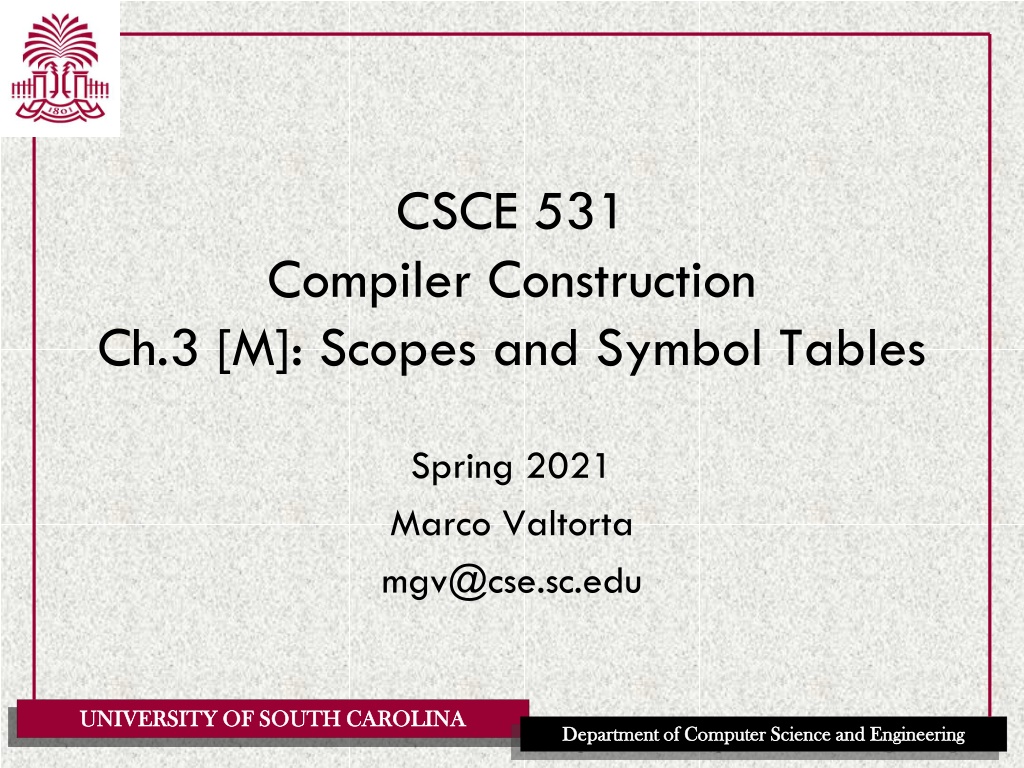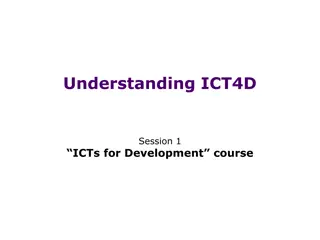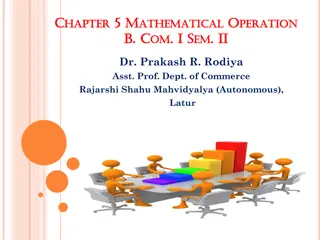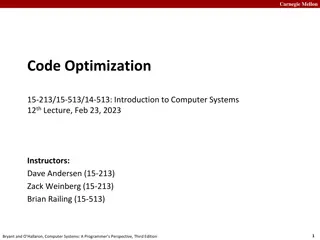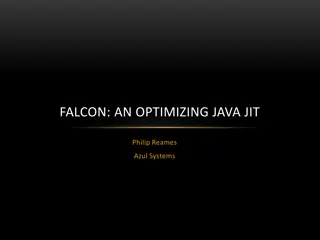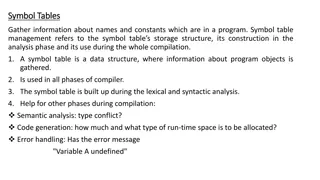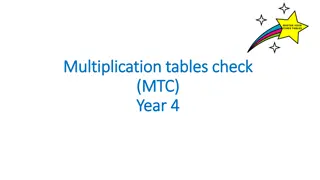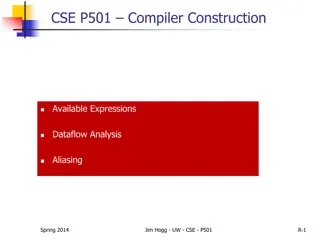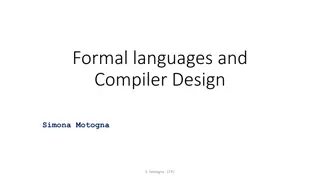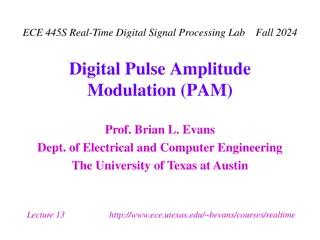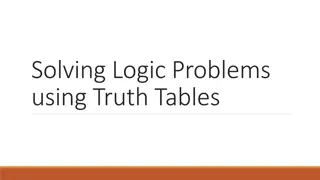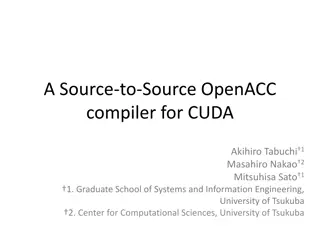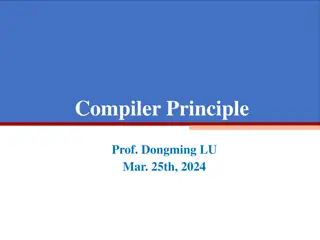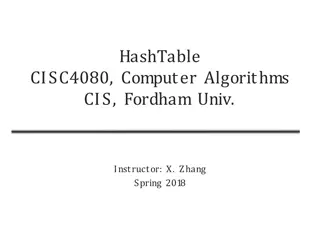Understanding Scopes and Symbol Tables in Compiler Construction
Scopes and symbol tables play a crucial role in programming languages by regulating the visibility of identifiers and establishing the relationship between binding and applied occurrences. Language issues such as single vs. multiple-pass compilation further impact the implementation of compilers, as shown through examples like Pascal's explicit design for single-pass compilation.
Download Presentation

Please find below an Image/Link to download the presentation.
The content on the website is provided AS IS for your information and personal use only. It may not be sold, licensed, or shared on other websites without obtaining consent from the author. Download presentation by click this link. If you encounter any issues during the download, it is possible that the publisher has removed the file from their server.
E N D
Presentation Transcript
CSCE 531 Compiler Construction Ch.3 [M]: Scopes and Symbol Tables Spring 2021 Marco Valtorta mgv@cse.sc.edu UNIVERSITY OF SOUTH CAROLINA UNIVERSITY OF SOUTH CAROLINA Department of Computer Science and Engineering Department of Computer Science and Engineering
Acknowledgment The slides use the required textbooks: [M] and [R] and other sources Watt, David A. and Deryck F. Brown. Programming Language Processors in Java. Prentice-Hall, 2000 [W] and slides from Bent Thomsen s course at the University of Aalborg in Denmark, based on it [M10]: the online version of the edition of Torben Mogensen s online textbook, Basics of Compiler Design The three main other compiler textbooks I considered are: Aho, Alfred V., Monica S. Lam, Ravi Sethi, and Jeffrey D. Ullman. Compilers: Principles, Techniques, & Tools, 2nded. Addison- Welsey, 2007. (The dragon book ) Appel, Andrew W. Modern Compiler Implementation in Java, 2nd ed. Cambridge, 2002. (Editions in ML and C also available; the tiger books ) Grune, Dick, Henri E. Bal, Ceriel J.H. Jacobs, and Koen G. Langendoen. Modern Compiler Design. Wiley, 2000; second edition 2012 [G] UNIVERSITY OF SOUTH CAROLINA UNIVERSITY OF SOUTH CAROLINA Department of Computer Science and Engineering Department of Computer Science and Engineering
Binding and Applied Occurences In programming languages, entities, such as constants, variables, types, and functions, can be named Naming occurs as part of binding Named entities can be used in their applied occurrences UNIVERSITY OF SOUTH CAROLINA UNIVERSITY OF SOUTH CAROLINA Department of Computer Science and Engineering Department of Computer Science and Engineering
Scope Rules Scope rules regulate visibility of identifiers. They relate every applied occurrence of an identifier to a binding occurrence Example 1 let const m~2; var r:Integer in r := 10*m ? Binding occurrence Example 2: let const m~2 in m + x Applied occurrence Terminology: Static binding vs. dynamic binding UNIVERSITY OF SOUTH CAROLINA UNIVERSITY OF SOUTH CAROLINA Department of Computer Science and Engineering Department of Computer Science and Engineering
Language Issues: Single vs. Multiple- Pass Compilation Example Pascal: Pascal was explicitly designed to be easy to implement with a single pass compiler: Every identifier must be declaredbefore its first use var n:integer; ? procedure inc; begin procedure inc; begin n:=n+1 end Undeclared Variable! n:=n+1 end; var n:integer; UNIVERSITY OF SOUTH CAROLINA UNIVERSITY OF SOUTH CAROLINA Department of Computer Science and Engineering Department of Computer Science and Engineering
Language Issues: Mutual Recursion Example Pascal: Every identifier must be declaredbefore it is used. How to handle mutual recursion then? procedure ping(x:integer) begin ... pong(x-1); ... end; procedure pong(x:integer) begin ... ping(x); ... end; UNIVERSITY OF SOUTH CAROLINA UNIVERSITY OF SOUTH CAROLINA Department of Computer Science and Engineering Department of Computer Science and Engineering
Language Issues Example Pascal: Every identifier must be declaredbefore it is used. How to handle mutual recursion then? forward procedure pong(x:integer) procedure ping(x:integer) begin ... pong(x-1); ... end; OK! procedure pong(x:integer) begin ... ping(x); ... end; UNIVERSITY OF SOUTH CAROLINA UNIVERSITY OF SOUTH CAROLINA Department of Computer Science and Engineering Department of Computer Science and Engineering
Language Issues Example SML: Every identifier must be declaredbefore it is used How to handle mutual recursion then? fun ping(x:int)= ... pong(x-1) ... fun pong(x:int)= ... ping(x) ... ; and OK! UNIVERSITY OF SOUTH CAROLINA UNIVERSITY OF SOUTH CAROLINA Department of Computer Science and Engineering Department of Computer Science and Engineering
Language Issues Example Java: identifiers can be usedbefore they are declared. thus a Java compiler needs at least two passes Class Example { void inc() { n = n + 1; } int n; void use() { n = 0 ; inc(); } } UNIVERSITY OF SOUTH CAROLINA UNIVERSITY OF SOUTH CAROLINA Department of Computer Science and Engineering Department of Computer Science and Engineering
Contextual Analysis Phase Purposes: Finish syntax analysis by deriving context- sensitive information Associate semantic routines with individual productions of the context free grammar or subtrees of the AST Start to interpret meaning of program based on its syntactic structure Prepare for the final stage of compilation: Code generation UNIVERSITY OF SOUTH CAROLINA UNIVERSITY OF SOUTH CAROLINA Department of Computer Science and Engineering Department of Computer Science and Engineering
Programming Language specification A Language specification has (at least) three parts: Syntax of the language: usually formal: EBNF Contextual constraints: scope rules (often written in English, but can be formal) type rules (formal or informal) Semantics: defined by the implementation informal descriptions in English formal using operational, denotational, or axiomatic semantics UNIVERSITY OF SOUTH CAROLINA UNIVERSITY OF SOUTH CAROLINA Department of Computer Science and Engineering Department of Computer Science and Engineering
The Phases of a Compiler Source Program Syntax Analysis Error Reports Today s lecture Abstract Syntax Tree Contextual Analysis Error Reports Decorated Abstract Syntax Tree Code Generation Object Code UNIVERSITY OF SOUTH CAROLINA UNIVERSITY OF SOUTH CAROLINA Department of Computer Science and Engineering Department of Computer Science and Engineering
Recap: Contextual Constraints Syntax rules alone are not enough to specify the format of well-formed programs. Example 1: let const m~2; in m + x Undefined! Scope Rules Example 2: let const m~2 ; var n:Boolean in begin n := m<4; n := n+1 end Type Rules Type error! UNIVERSITY OF SOUTH CAROLINA UNIVERSITY OF SOUTH CAROLINA Department of Computer Science and Engineering Department of Computer Science and Engineering
Scope Rules Scope rules regulate visibility of identifiers. They relate every applied occurrence of an identifier to a binding occurrence Example 1 let const m~2; var r:Integer in r := 10*m ? Binding occurence Example 2: let const m~2 in m + x Applied occurence Terminology: Static binding vs. dynamic binding See Example 1.6 (pp.16-17) in [W]. UNIVERSITY OF SOUTH CAROLINA UNIVERSITY OF SOUTH CAROLINA Department of Computer Science and Engineering Department of Computer Science and Engineering
Static vs Dynamic Binding This example is from [W], pp.16-17. Here is a Triangle program. Triangle uses static binding. let const m ~ 2; var n: Integer; func f (i: Integer) : Integer ~ i * m in begin ; n := f(n); (1) ; end Under static (also called lexical) binding, the function f always doubles its argument. UNIVERSITY OF SOUTH CAROLINA UNIVERSITY OF SOUTH CAROLINA Department of Computer Science and Engineering Department of Computer Science and Engineering
Static vs Dynamic Binding For example: let const m ~ 3 in ... f(n) ... (2) (a call to f(n)) The function call at point (2) doubles its argument, because the applied occurrence of m inside the function f always denotes 2, regardless of what it denotes at the point of call. In a language with dynamic binding, f(n) would triple its argument instead, because the applied occurrence of m would denote the value in which m was most recently bound. Static (also called lexical) binding is prevalent in modern programming languages. UNIVERSITY OF SOUTH CAROLINA UNIVERSITY OF SOUTH CAROLINA Department of Computer Science and Engineering Department of Computer Science and Engineering
Static vs Dynamic Binding Here is an example in C [M, p.97] The two lines immediately after the first opening brace declare integer variables x and y with scope until the closing brace in the last line. A new scope is started by the second opening brace and a floating-point variable x with an initial value close to pi is declared. This will have scope until the first closing brace, so the original x variable is not visible until the inner scope ends. The assignment y += (int)x; will add 3 to y, so its new value is 5. In the next assignment y += x;, we have exited the inner scope, so the original x is restored. The assignment will, hence, add 1 to y, which will have the final value 6. UNIVERSITY OF SOUTH CAROLINA UNIVERSITY OF SOUTH CAROLINA Department of Computer Science and Engineering Department of Computer Science and Engineering
Symbol Tables For a language with nested block structure (as most modern programming languages: see next slide), a compiler needs to keep track of the right declaration (binding occurrence) for each use (applied occurrence) of an entity. One could imagine annotating the syntax tree with declarations and traversing it every time an entity is used. This is inefficient Most compilers use a symbol table (sometimes called identification table) instead As an abstract data type, a symbol table can be implemented in different ways UNIVERSITY OF SOUTH CAROLINA UNIVERSITY OF SOUTH CAROLINA Department of Computer Science and Engineering Department of Computer Science and Engineering
Symbol Tables as ADTs Many compilers use a symbol table for binding. As an Abstract Data Type (ADT), a symbol table supports the following needs through several operations [M, p.98]: We need an empty symbol table, in which no name is defined. We need to be able to bind a name to a piece of information. In case the name is already defined in the symbol table, the new binding takes precedence over the old. We need to be able to look up a name in a symbol table to find the information the name is bound to. If the name is not defined in the symbol table, we need to be told that. We need to be able to enter a new scope. We need to be able to exit a scope, reestablishing the symbol table to what it was before the scope was entered. UNIVERSITY OF SOUTH CAROLINA UNIVERSITY OF SOUTH CAROLINA Department of Computer Science and Engineering Department of Computer Science and Engineering
Nested Block Structure A language exhibits nested block structure if blocks may be nested one within another (typically with no upper bound on the level of nesting that is allowed). Nested There can be any number of scope levels (depending on the level of nesting of blocks): Typical scope rules: no identifier may be declared more than once within the same block (at the same level). for any applied occurrence there must be a corresponding declaration, either within the same block or in a block in which it is nested. Note that the block (scope) that is exited first is the last one to be entered, as in a stack (LIFO data structure). UNIVERSITY OF SOUTH CAROLINA UNIVERSITY OF SOUTH CAROLINA Department of Computer Science and Engineering Department of Computer Science and Engineering
Implementing Symbol Tables [M, 3.1.2] In functional languages, since there is no destructive assignment, data structures are persistent. Conceptually, each time an operation updates the symbol table, a new one is created. This makes retrieving the correct (previous) symbol table when exiting a scope easy. In imperative languages, only one copy of the symbol table exists, and a mechanism is needed to restore the symbol table to the correct state for the previous scope. An auxiliary stack can be used for this purpose. UNIVERSITY OF SOUTH CAROLINA UNIVERSITY OF SOUTH CAROLINA Department of Computer Science and Engineering Department of Computer Science and Engineering
Simple Persistent Symbol Tables: List Implementation We consider two approaches to implementation of persistent (functional) symbol tables: lists (this slide) and functions. A symbol table is just a list of bindings, and each binding is a (name, information) pair. The implementation of empty, bind, and lookup is straightforward. As new bindings are added to the front of the list, bindings from inner scopes take precedence. enter: The old list is remembered, i.e., a reference is made to it. exit: The old list is recalled, i.e., the above reference is used. The latter two operations are not really explicit operations, as the variable used to hold the symbol table before entering a new scope will still hold the same symbol table after the scope is exited. So all that is needed is a variable to hold (a reference to) the symbol table. UNIVERSITY OF SOUTH CAROLINA UNIVERSITY OF SOUTH CAROLINA Department of Computer Science and Engineering Department of Computer Science and Engineering
Simple Persistent Symbol Tables: Function Implementation A symbol table is seen as a function from names to information. empty: An empty symbol table is a function that returns an error indication (or raises an exception) no matter what its argument is. binding: Adding a binding of the name n to the information i in a symbol table tis done by defining a new symbol-table function t in terms of t and the new binding. When t is called with a name n1 as argument, it compares n1 to n. If they are equal, t returns the information i. Otherwise, t calls twith n1 as argument and returns the result that this call yields. In Standard ML, we can define a binding function in this way: fun bind(n,i,t)=fn n1 => if n1=n then i else t n1 to be used as follows: t = bind (n,i,t) lookup: The symbol-table function is called with the name as argument. enter: The old function is remembered (referenced). exit: The old function is recalled (by using a reference) UNIVERSITY OF SOUTH CAROLINA UNIVERSITY OF SOUTH CAROLINA Department of Computer Science and Engineering Department of Computer Science and Engineering
A Simple Imperative Symbol Table The symbol table is a stack. This simplifies the handling of nested scopes: no auxiliary stack is needed, and the scope markers are stored in the symbol table (cf. enter and exit). empty: An empty symbol table is an empty stack. binding: A new binding (name/information pair) is pushed on top of the stack. lookup: The stack is searched top-to-bottom until a matching name is found. The information paired with the name is then returned. If the bottom of the stack is reached, we instead return an error-indication. enter: We push a marker on the top of the stack. exit: We pop bindings from the stack until a marker is found. This is also popped from the stack. UNIVERSITY OF SOUTH CAROLINA UNIVERSITY OF SOUTH CAROLINA Department of Computer Science and Engineering Department of Computer Science and Engineering
Efficiency Issues [M, 3.1.4] In all simple implementations, lookup is done by linear search, so the worst-case complexity (using comparison of names as characteristic operations) is proportional to the size of the symbol table. A common solution to this problem is hashing: Names are hashed (processed) into integers, which are used to index an array. Using hash tables complicates entering and exiting scopes. While each element of the hash table is a list that can be handled like in the simple cases, reorganizing all the array elements at every entry and exit imposes a major overhead. Instead, it is typical for imperative implementations to use a single auxiliary stack to record all updates to the table so they can be undone in time proportional to the number of updates that were done in the local scope. Functional implementations typically use persistent hash-tables or persistent binary search trees, which eliminates the problem. UNIVERSITY OF SOUTH CAROLINA UNIVERSITY OF SOUTH CAROLINA Department of Computer Science and Engineering Department of Computer Science and Engineering
Shared or Separate Name Spaces [M, 3.1.5] In Pascal, functions and variables have separate name spaces, which means that defining a name in one space doesn t affect the same name in the other space. In C and SML, the context can not (easily) distinguish variables from functions. Declaring a local variable might hide a function declared in an outer scope or vice versa. These languages have a shared name space for variables and functions (and possibly other named entities such as types, exceptions, constructors, classes, field selectors). Which name spaces are shared is language-dependent. Separate name spaces are easily implemented using one symbol table per name space, whereas shared name spaces naturally share a single symbol table. However, it is sometimes convenient to use a single symbol table even if there are separate name spaces. This can be done fairly easily by adding name-space indicators (e.g., tags) to the names. UNIVERSITY OF SOUTH CAROLINA UNIVERSITY OF SOUTH CAROLINA Department of Computer Science and Engineering Department of Computer Science and Engineering
